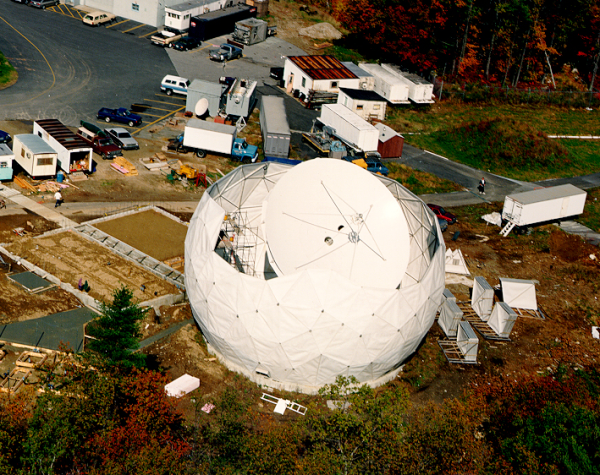The Haystack Auxiliary Radar (HAX) is a wideband radar located at the Lincoln Space Surveillance Complex near Boston, the same site as the Haystack imaging radar and the Millstone Hill tracking radar.[1] As a contributing sensor in the Space Surveillance Network (SSN) it is used for imaging near-earth orbit satellites, and it is also an important sensor for scientific studies aimed at characterizing the near-earth space debris environment.
HAX Radar Under Construction (image from: http://www.orbitaldebris.jsc.nasa.gov/measure/images/radar_dome.jpg)
Background
HAX came about because the part-time usage arrangements the Air Force and NASA had made for use of the Haystack radar for satellite tracking, imaging and space debris studies were found to be insufficient. HAX was seen as an opportunity to increase both the available viewing time and the radar resolution.
Although HAX is a much smaller radar than Haystack and thus has a shorter range (in particular it does not appear to be capable of imaging out to geosynchronous orbit as Haystack can), its bandwidth is twice that of Haystack and it is thus capable of producing correspondingly sharper images of near-earth orbit objects.
The cost of building HAX was reduced by using a refurbished antenna and by sharing signal processing and data processing systems with the Haystack LRIR (which meant that the two radars could not operate simultaneously). NASA ultimately agreed to fund HAX in return for access to both Haystack and HAX for space debris studies. Like Haystack, HAX is a contributing sensor in the SSN.
It became operational in the fall 1993, and was the first large radar to have a bandwidth of 2 GHz.
Technical Characteristics
HAX operates in Ku band, at a center frequency of about 16.7 GHz, corresponding to a wavelength of 1.8 cm. It has a 40 foot (12.2 m) antenna in a 50 foot radome, giving a beam width is 0.1˚ and an antenna gain of 64 dB (= 2,500,000). It has a bandwidth of 2 GHz, giving a range resolution of 12 cm.
HAX’s peak power is about 50 to 60 kW. According to a 2000 paper, its maximum duty cycle was 30%.[2] This would give it a maximum average power of about 15-18 kW. In its wideband (imaging) mode, its maximum pulse length was 256 μs with a maximum pulse repetition of 975. However, at that time, an upgrade to the processing and control systems off all three LSSC radars was planned and since has apparently been completed.[3] This upgrade was to involve new variable wideband pulse lengths and increased maximum pulse repetition frequencies (and also possibly remove the limitation on simultaneous operation with Haystack?).
Capabilities and Operations
As of 2000, HAX was available for near earth imaging 16 hours per day, five days per week, 16 hours per day.[4] In 1999, Haystack and Hax together produced 756 imaging tracks and a total of over 14,000 images.
According to a 1997 paper, HAX could achieve a narrowband single-pulse sensitivity of 43 dB with a 2.009 ms pulse.[5] A 2006 paper gives a somewhat lower sensitivity of 40.5 dB with a 1.64 ms pulse. For space debris characterization operations, HAX typically non-coherently integrates a number (12-16) of narrow band pulses and is able to detect objects down to about 2 cm in size.[6]
At least prior to the upgrade of its processing and control systems, HAX’s wideband operations used only 0.256 ms pulses, and so its single pulse sensitivity would have been lower. A 1993 paper[7] states that the wideband single-pulse sensitivity (1 m2 at 1,000 km) of HAX was about 38 dB (somewhat higher than would have been expected given the above narrowband sensitivities). However one of the intended outcomes of the upgrade was to enable longer wideband pulses.
[1] Unless otherwise noted, information in this discussion is from: William W. Camp, Joseph T. Mayhan, and Robert M. O’Donnell, “Wideband Radar for Ballistic Missile Defense and Range-Doppler Imaging of Satellites,” Lincoln Laboratory Journal, Vol. 12, No. 2 (2000), pp. 267-280, and Chapter 8: “Space Surveillance,” in Eva C. Freeman, ed., MIT Lincoln Laboratory: Technology in the National Interest (Lexington, Mass.: Lincoln Laboratory, 1995).
[2] T. Sangiolo, “Lincoln Space Surveillance Complex (LSSC) Modernization,” Proceedings of the 2000 Space Control Conference, Lincoln Laboratory, April 11-13, 2000, pp. 175-181.
[3] Sangiolo, “Lincoln Space Surveillance Complex (LSSC) Modernization.”
[4] Fred D. Rosenberg, “Operations at the Lincoln Space Surveillance Complex,” 2000 Space Control Workshop, Lincoln Laboratory, April 11-13, 2000, pp. 169-174.
[5] Gene Stansbery and Tom Setticerri, “HAX Radar,” Orbital Debris Quarterly News, January-March, 1997, p. 8.
[6] C. L. Stokely, J. L. Foster, Jr., E.G. Stansbery, J. L. Benbrook, and Q. Juarez, Haystack and HAX Radar Measurements of the Orbital Debris Environment: 2000, NASA Lyndon B. Johnson Space Center, JSC-62815, November 2006.
[7] Lee B. Spence and Richard J. Temkin, “A Very High Power, Wide Bandwidth Imaging Radar Design,” 1993 IEEE National Radar Conference, pp. 182-185.
